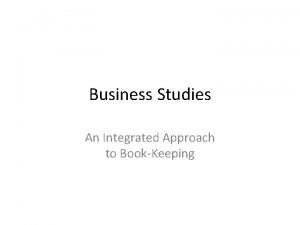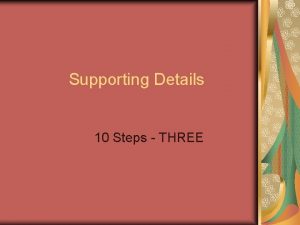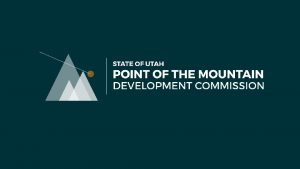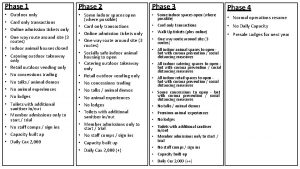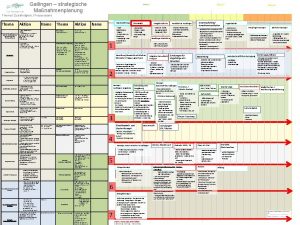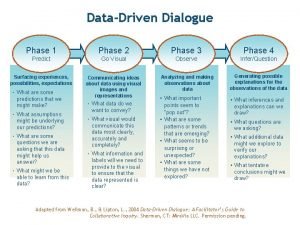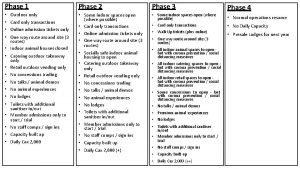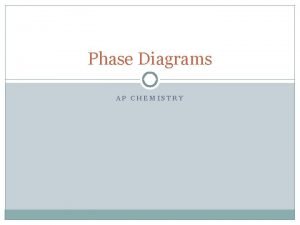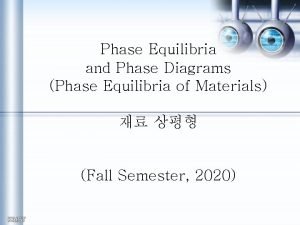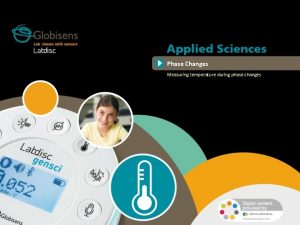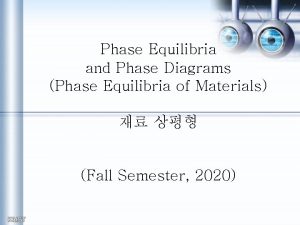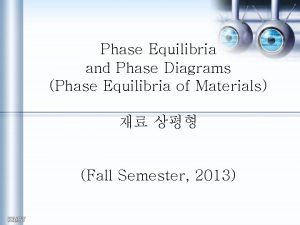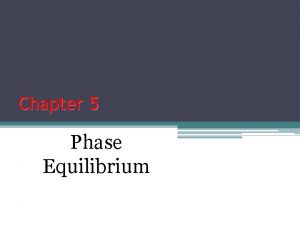PHASE 5 An Integrated Approach to Supporting Students


















- Slides: 18

PHASE 5 An Integrated Approach to Supporting Students on the Autism Spectrum Indiana University of Pennsylvania Ashley Baksis, Julieze Benjamin & Ashley Reese (team leader)

Presented by Ashley Reese Ashley Baksis Julieze Benjamin Director of Student Engagement Office of Student Activities Director of Disability Services Team Leader Dean of Students, Office of Student Affairs

“Not Every Disability is Visible” The Phase 5 committee seeks to create a campus wide initiative that supports students on the Autism Spectrum through Academic, Personal, and Behavioral facets (The University of Warwick, 2016; Anderson, 2015)

Autism Spectrum Disorders (ASD) ● ASD is an umbrella term for multiple developmental disorders ● Symptoms range from mild to severe ● Invisible disability Characteristics include: ● Communication difficulties ● Social and/or interpersonal incongruence ● Repetitive and restrictive behaviors ● Hypersensitive focus on objects and tasks ● Developed cognitive/intellectual capabilities (White, Ollendik & Bray, 2011; Whitman, 2000, p. 22 ) https: //csd. wisc. edu/slp-autism-spectrum-disorder. htm (Image)

Exponential Increase ● It is estimated that students with ASD comprise anywhere from 0. 7 percent to 1. 9 percent of the college population ● Of those enrolled in higher education 80% do not persist ● We recognize that the number of students who selfreport a diagnosis of ASD has risen and will likely continue ● With this information and our commitment to embrace diverse student populations, we propose the creation of a holistic support program (https: //www. heath. gwu. edu/students-autism-college-classroom; Grogan, 2015; Zedaker, 2016) https: //communityimpact. com/houston/healthcare/ 2016/07/13/rise-autism-prevalence-causingdemand-local-services/

Transition to College Students with ASD experience a shift within their rights, responsibilities, and services when they transition to college Pre. College Limited S t Respons udent ibility Depende nt Living “Approximately 26% of young adults on the autism spectrum receive no services” (Grogan, 205; Roux, Shattuck, Rast, Rava, & Anderson, 2015, p. 25) Docume n by Guard ted Disability ian or Ed ucator College Studen Conduct/B t ehavior Higher Fin a Responsib ncial ility Self-Adv ocacy & Self-Disc losure Indepen de Decrease nt Living & in Servic es

Legislation: Shift in Rights & Responsibilities Individuals with Disabilities Education Act, 1975 Section 504 Americans with Disabilities Act, 1990 Who is covered? Students with educational disabilities from ages 3 -21 (or until graduation) Protects everyone with a disability from discrimination in educational settings Protects everyone with Protects students with a disability from intellectual disabilities discrimination within state and government entities Requirements under the law Provides free public education Provides equal opportunity in education; prohibits discrimination based on disability Extends section 504 to include private education; prohibits discrimination based on disability Improves access to postsecondary education at institutions that receive Federal funding Focus Education focused on student success Education focused on reasonable accommodations and equal access Education focused on equal access Improves access through financial aid and transition programs (U. S. Department of Education, 2015) Higher Education Opportunity Act, 2008

Theory to Practice Success Students with ASD can be successful with the support of programs that assist them in learning to manage their emotions, become interdependent, develop mature interpersonal relationships, and develop a purpose (Chickering & Reisser, 1993) Growth Development “Approximately one in four young adults with autism was socially isolated. They never saw or talked with friends, and were never invited to social activities within the past year” (Roux, Shattuck, Rast, Rava, & Anderson, 2015, p. 55)

What are other Universities doing? Western Kentucky University Indiana University of Pennsylvania Rutgers University Indiana University of Bloomington Kelly Autism Program Labyrinth Center College Support Program Resource Center for Autism

Structure Contributes to Success • Research shows that students with Autism Spectrum Disorder benefit from structured environments • As professionals, it is our responsibility to create an environment that provides structure and support to ALL students as outlined by the CAS standards Phase 5 will be created to establish the structure that is essential to the success of Autism Spectrum Disorder students Academic Skills & Success Selfadvocacy & support networks Personal & Social Competence Independent Living Behavioral & Safety Coaching

Phase 5: An Integrated Approach BEHAVIORAL & SAFETY COACHING SELF ADVOCACY & SUPPORT NETWORKS Safety and security skills Behavioral instruction Self-care strategies Conflict Resolution Partnership with: Parents/guardians Student Affairs Academic Affairs (Wolf, Brown, & Bork, 2009) ACADEMIC SKILLS & SUCCESS Organization skills Career exploration Time management Employment skills INDEPENDENT LIVING PERSONAL & SOCIAL COMPETENCE Residential living Medication management Personal wellness Financial literacy Interpersonal communication Relationship skills Healthy boundaries Campus engagement

Short Term Plan Launch Phase 5 an integrated support for ASD Students • Pre-Orientation for ASD Students (1 week duration) • Engagement and Programming: 1 credit course, weekly meetings, and monthly newsletter • Create a sustainable Phase 5 structure (Student Phase 5 Application & Selection • Advertise through the Admissions Office and Disability Services (Application) • Select 25 first year residential students to participate in the Phase 5 Affairs and Academic Affairs integration) Application and Selection Process Host Pre. Orientation for ASD Students Phase 5 Engagement and Programing

Engagement and Programing Once selected, students will attend a 1 Credit Course • Cohort course • Facilitated by a graduate assistant accompanied by an upper class peer mentor • Designed to support ASD students successful transition, adjustment and integration from high school to college week long preorientation for introduction to the Phase 5 program Weekly Phase 5 Meetings • Each week cohort members will learn about programs and engagement opportunities on campus • Designed to enhance students personal competence, social competence, independent living skills, and behavioral and coaching Monthly Newsletter • Digital newsletters will be sent to students and their support networks (parents/guardians, educators, and administration) • Designed to promote ongoing communication and advocacy resources (Emerging practices for supporting students on the autism spectrum in higher education: A guide for higher education professionals, 2014)

Program Budget Purpose Participants Price/Each Total Housing Pre-Orientation 25 Students 1 Graduate Assistant 1 Upper-class student Subsidized by internal funding Dining Pre-Orientation 25 Students 1 Faculty & 1 Staff member 1 Graduate Assistant 1 Upper-class student $20. 00 person/ per day $4, 060. 00 T-shirts Pre-Orientation 29 t-shirts $3. 00 per shirt $87. 00 Printing Cost (5 page handout) Pre-Orientation 25 $0. 50 per program $12. 50 Phase 5 Office Space N/A FREE Staff Honorarium Service and/or flex-time for N/A faculty & staff member N/A Operations Resource Materials N/A $1750. 00 Total Expected Cost $1750. 00 $5, 909. 50

Long Term Plan Secure Funding and Operation Budget • Pre-Orientation cost • Office and meeting space • Support service resources • Direct assessment (pre-orientation and end of the year skills assessment) • Indirect assessment (semester student satisfaction survey and parent/guardian survey) • Staffing Assessment and Evaluation Continuous Updates to the Board of Trustees on Annual Success Secure Funding and Operational Budget

What Students “Having autism doesn’t limit our abilities. Autism just changes our thought process and the way we perceive things” -Phil Martin With Autism “One of the biggest challenges of being autistic is not autism itself, but how other people react to it. If you to change lives, start by changing Want You To Know…. . your perception of autism” -Amy Gravino “People with autism have a special window to the world. Our lens allows us to see depth and a perspective that many miss” -Ann Kagarise (Autism Speaks, 2017)

References Anderson, Deanne. (2015). CT students with disabilities need to choose college wisely. Retrieved from http: //ctviewpoints. org/2015/08/11/choosing-a-college/. • Evans, N. J. , Forney, D. S. , Guido, F. M. , Patton, L. D. , & Renn, K. A. (2010). Student development in college: Theory, research, and practice (2 nd edition). San Francisco, CA: Jossey Bass. • Emerging practices for supporting students on the autism spectrum in higher education: A guide for higher education professionals. (2014). Retrieved from https: //www. rit. edu/~wssp/documents/ASDin. Higher. Ed. Guide. pdf • Grogan, Gina. (2016). Supporting Students with Autism in Higher Education through Teacher Educator Programs. Retrieved http: //files. eric. ed. gov/fulltext/EJ 1083126. pdf • Roux, A. , Shattuck, P. , Rast, J. , Rava, J. , and Anderson, K. National Autism Indicators Report: Transition into Young Adulthood. Philadelphia, PA: Life Course Outcomes Research Program, A. J. Drexel Autism Institute, Drexel University, 2015. • White, S. W. , Ollendick, T. C. , Bray, B. C. (2011). College student on the autism spectrum: Prevalence and associated problems. •

References Continued Whitman, Thomas. (2000). The development of autism: A self-regulatory perspective. Wolf, L. E. , Brown, J. T. , & Bork, G. R. K. (2009). Students with Asperger syndrome: A guide for college personnel. • U. S Department of Education, National Center for Education Statistics. (2015). Digest of Education • Zedaker, Hannah. (2016). Rise in autism prevalence causing more demand for local services. Retrieved from https: //communityimpact. com/houston/healthcare/2016/07/13/riseautism-prevalence-causing-demand-local-services/ • [“Not every disability is visible”] Retrieved from http: //www 2. warwick. ac. uk/services/equalops/disability/ • https: //www. autismspeaks. org/family-services/tool-kits/transition-tool-kit/post-secondaryeducational-opportunities • https: //www. autismspeaks. org/blog/2016/04/02/10 -things-people-autism-want-you-know • https: //www. heath. gwu. edu/students-autism-college-classroom • https: //childmind. org/article/going-to-college-with-autism/ • •
 Rizal visit to pakil and pagsanjan
Rizal visit to pakil and pagsanjan Normal phase vs reverse phase chromatography
Normal phase vs reverse phase chromatography Hplc reverse phase vs normal phase
Hplc reverse phase vs normal phase Mobile phase and stationary phase
Mobile phase and stationary phase Stationary phase and mobile phase in hplc
Stationary phase and mobile phase in hplc Normal phase vs reverse phase chromatography
Normal phase vs reverse phase chromatography Phase to phase voltage
Phase to phase voltage Adsorption chromatography
Adsorption chromatography In a ∆-connected source feeding a y-connected load
In a ∆-connected source feeding a y-connected load Csce 441
Csce 441 An integrated approach to business studies
An integrated approach to business studies Difference between datagram and virtual circuit network
Difference between datagram and virtual circuit network Theoretical models of counseling
Theoretical models of counseling Waterfall and shower approach
Waterfall and shower approach Multi approach avoidance conflict
Multi approach avoidance conflict Bandura's reciprocal determinism
Bandura's reciprocal determinism What is a research
What is a research Traditional development approach
Traditional development approach Deep learning approach and surface learning approach
Deep learning approach and surface learning approach










